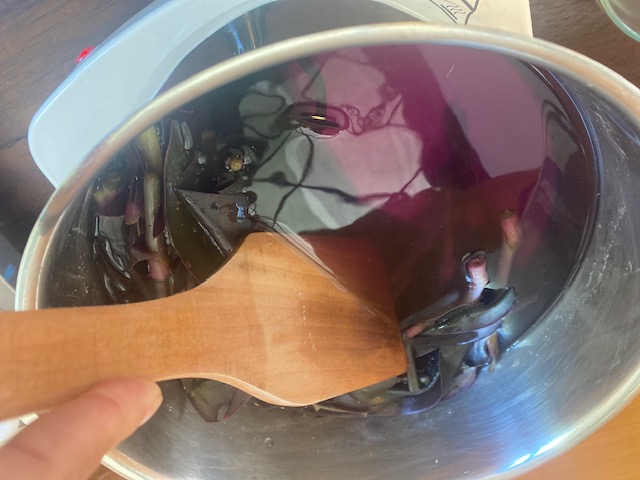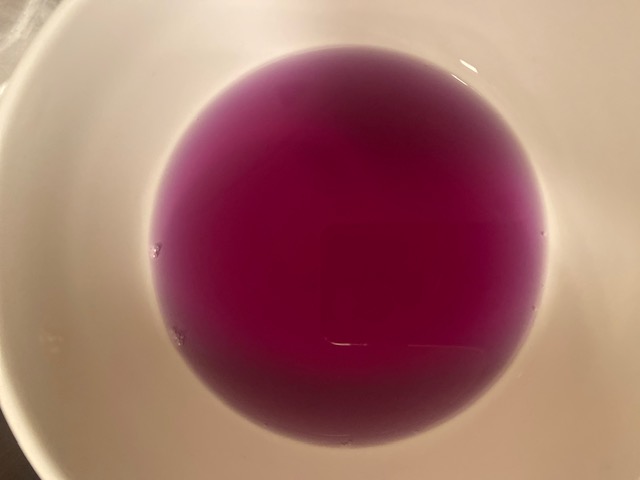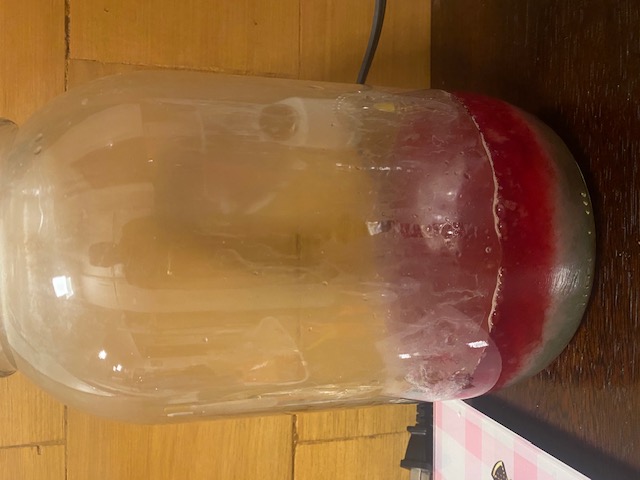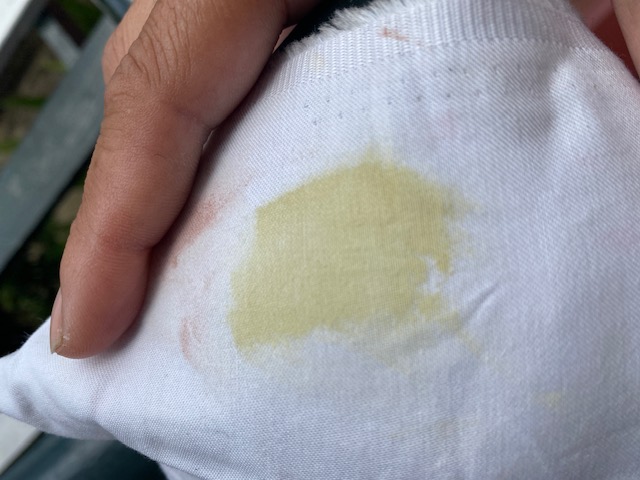4. BioChromes¶
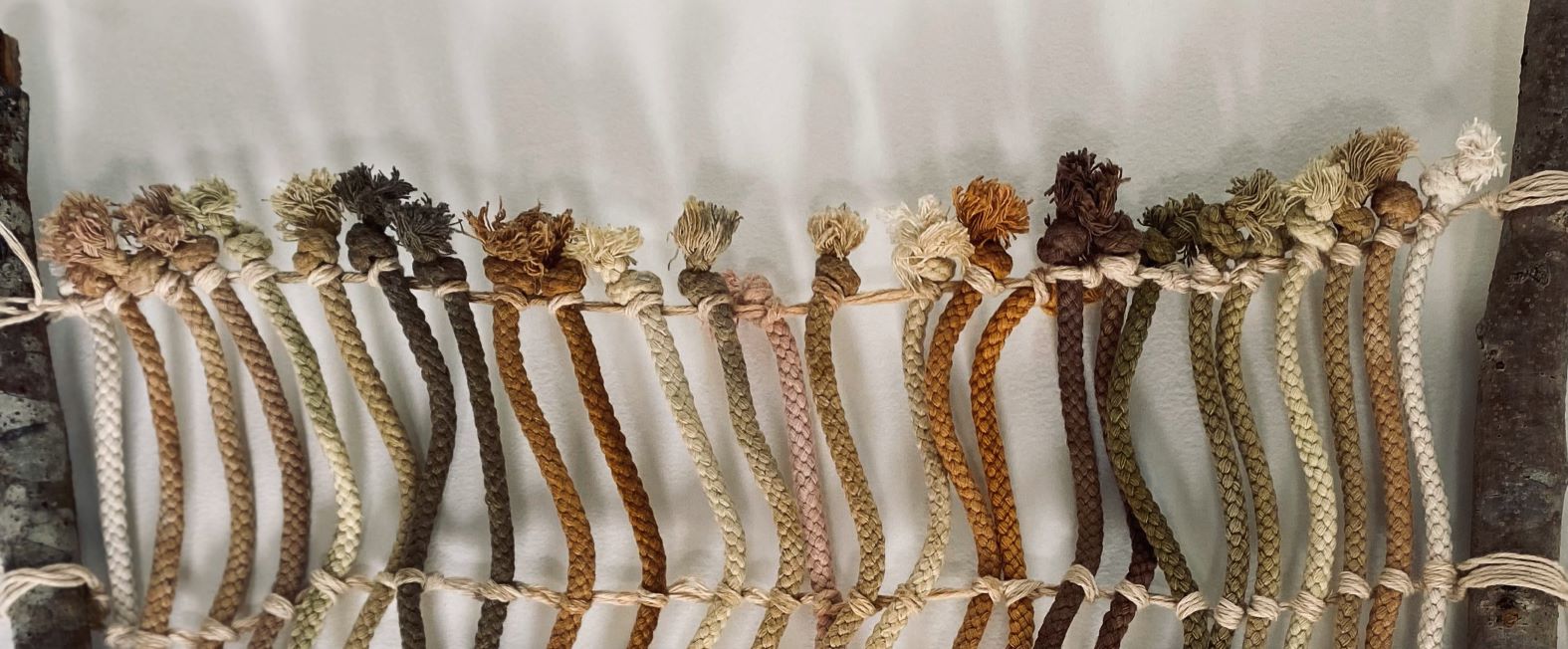
For this weeks biochromes assignment I made a wallpiece from 25 pieces of colored cotton. The piece is also a first concept for a hammock, which I will eventually make with biochromes from the Amazon rainforest.
Research¶
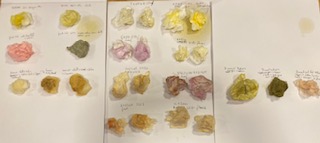
This subject of biochromes is completely new for me. Having said that, the biochromes assignment has given me another reason to explore the Amazon rainforest. The tropical region is an abundant source of color. According to a recent study aiming to answer the question why tropical birds have much brighter colors that other regions, published in 2022:
"... the study suggests that the fruit-rich diet in tropical zones would also influence animal coloring. Places like the Amazon have an abundance of fruits like mango, acerola cherry (Malpighia emarginata), tucumã (Astrocaryum aculeatum) and umari (Poraqueiba sericea), all rich in carotenoids, a group of yellow, orange and red organic pigments. Those very colors found in in birds, ... are typically produced by carotenoid pigments deposited inside them. "
The article gave me some clues where to look for color in my natural environment:
* mango
-
acerola cherry (Malpighia emarginata)
-
tucumã (Astrocaryum aculeatum)
-
umari (Poraqueiba sericea)
I later crowdsourced my question to an online Surinamese gardening community on FB "Surinaamse tuin, groenten en fruit" and got 19 different answers making up the following list (Please bear with me: I'll adjust with the Latin and english names):
-
Spinach - green
-
hibiscus - red
-
beets -red
-
Butterfly pea clitoria - blue, with a drop of lime it turns purple
-
kurkuma - yellow
-
Koesoewe -red orange
-
Sjuru -red
-
Djamoen -red
-
Onion peel -red
-
Masoesa peel -yellow
-
Dahlias flowers (no color mentioned)
-
Pandan leave -green
-
Awara -orange
-
Agave (no color mentioned)
-
Broedoewirie -red
-
Birambi flowers- red
-
Red lotus bark- red
-
Tupuru root - purple
-
Rice hush - burn to turn black
So I narrowed it down to the following plants and fruits:
-
Pandan (green) X
-
Broedoe wiri (Red)
-
Vern (Red)
-
Awara (Orange)
-
Koesoewe (red) X
-
Masoesa (Yellow/Orange)
-
Gado libi (Deep Purple) X
And as you will see in my documentation: later this list changed! I put an X behind the items I did do and added the following:
-
Korsu Wiri X
-
Amana oil X ( Credits to BDC Saamaka Gangasa who produced and bottled the orange palm oil)
-
Brazilian Hot Red X. This is a really spectacular plant that turns more and more red- deep pink the more sun it gets.
In that same spirit of localism additionally I'm trying an alternative tannin: Mangrove! I read online that this is used in India for fishnets.
This is exciting! Amazon Rainforest power!
THE PROCESS¶
Fieldwork: Picking plant material¶
- I picked my dye plants, I had a few legal sources here: my garden, my moms garden and the mini rainforest planted by Villa Zapakara, which owns Zaplab, a very cool fablab with children and teens as the main focus group. (Please find my timelaps walking though the mini forest in the links)
It was really really HOT that day!!

It was also great to socialize with some of my Fab friends. Here is Linde Braber showing her GoBana brand: bags made from banana leaves by women in the rural area of Saramacca



Choosing which fabrics to color¶
- Back to the process: I decided to color a beautiful craft cotton rope.
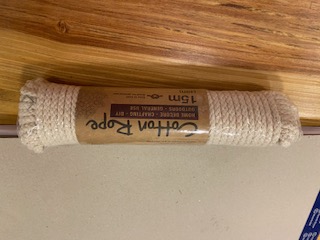
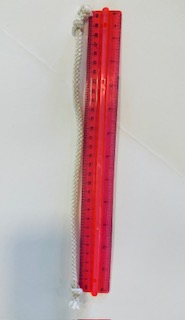

Preparing the fabrics¶
- I first cut the rope in pieces of about 30 cm and 4 to 5 grams.
- I boiled all the ropes (40) for an hour to get all the dirt out. The water looked like tea. (Yuk)
- I then hung them out to dry and later put them in the sun to dry even faster.


Testing colors¶
- In addition I also did a tissue test to catch the colors quickly since the rope took about 3 days to prep and the soak in the colorbath. The tissue test gave me instant color and a nice color pallet that looked quite different from the ropes too.


Tanning to sustain colors and fabrics¶
- Tannin with Mangrove leaves
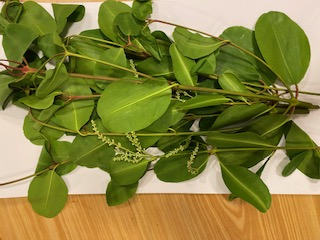
- After some searching I got two choices for tannin: Mangrove and tea. I decided to tannin half of the ropes (20) with Magrove leaves and the other halve with black tea. Later I did find a store that sells Alum so instead of tea I did the tannin with Alum as instructed. It gave a nice difference between a lighter (Alum) and darker (Mangrove tannin)cotton rope version of the same color.
-
I stole... I mean I borrowed without asking... some mangrove leaves, branches and flowers from my favorite hotel garden by the Suriname river, hotel Torarica. If you ever visit Suriname make sure to stay there! Or I have a guestroom so you're invited.... sideline, back to the process.
-
Then I made a calculation based on Chat GTPs analysis that Mangrove leaves have 2 to 10% (average 6%) Tannin compared with Oakgal 30 to 70% (Average 50%), So if for Oakgal I would need 15% of the weight then for Mangrove I would need approximately 8 times more which is 120% of the weight of the rope. So that would be 120% X 0.5 X184 grams = 110 grams of Mangrove leaves.
- I washed and cleaned the mangroveleaves and branches, chopped it and brought it to a boil in 2 liter pot. Put in the cotton ropes for 30 minutes, after which I cleaned the rope from the residu of Magrove leaves.
- Secondly I boiled the ropes in a pot with sodium carbonate. Ofcourse when I first bought this I bought regular baking soda instead of sodium carbonate but after the instruction to bake it in the oven for an hour at 350 degrees, which I did, I felt a sly chemistry pride afterwards. I cooled it down and put the final product in a sealed glass pot with a label on it so no one mistakes it for sugar or salt. When I was finished with this step I hung the ropes out to dry for a second time.
Here is the process in pictures:
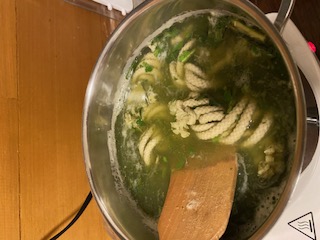
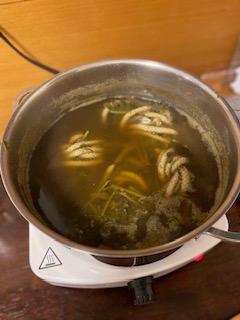
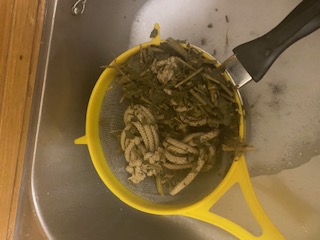
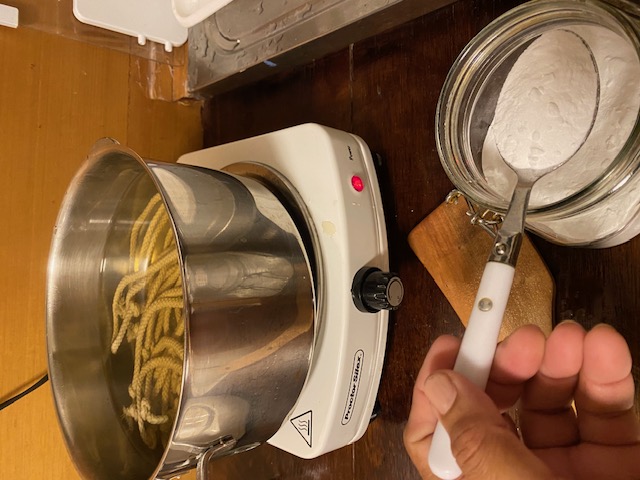
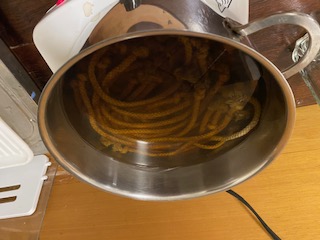
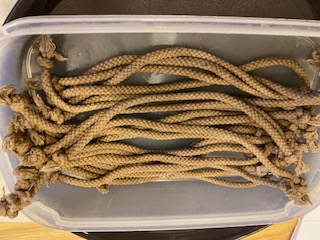
- Mordant: Because I first could not find any Alum, I decided to use the following mordands and binders: Sodium Carbonate, Vinegar, Lime, Soy Milk, Salt, Iron and Copper. Then a surprise! The shop (Ali's drugstore) where I planned to buy Soy, happened to have Alum! So I got to mordant the second batch with Alum anyway! Later I found more sources for alum.
The Actual dying process¶
-
Ready to dye?
-
Pandan Pandanus amaryllifolius; Pandan Green leave dye
Pandan leaves: the green dye can be extracted cold or with luke warm water.

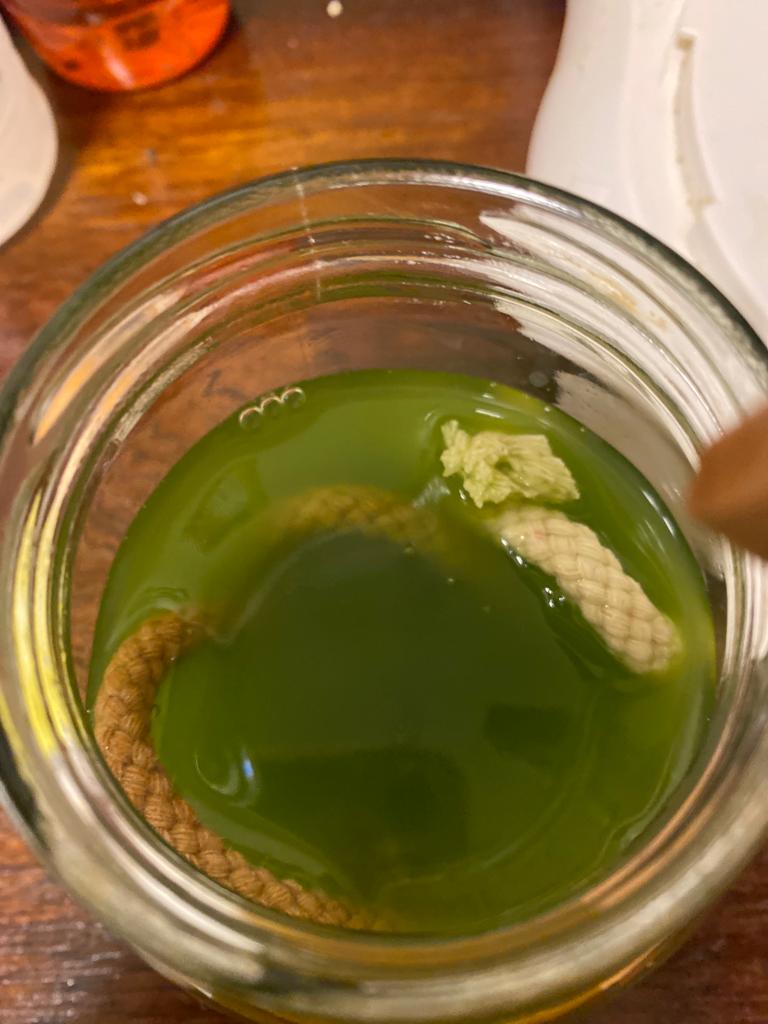
- Bixa orellana; Annatto; Koeswe; Koesoewe seed Red dye
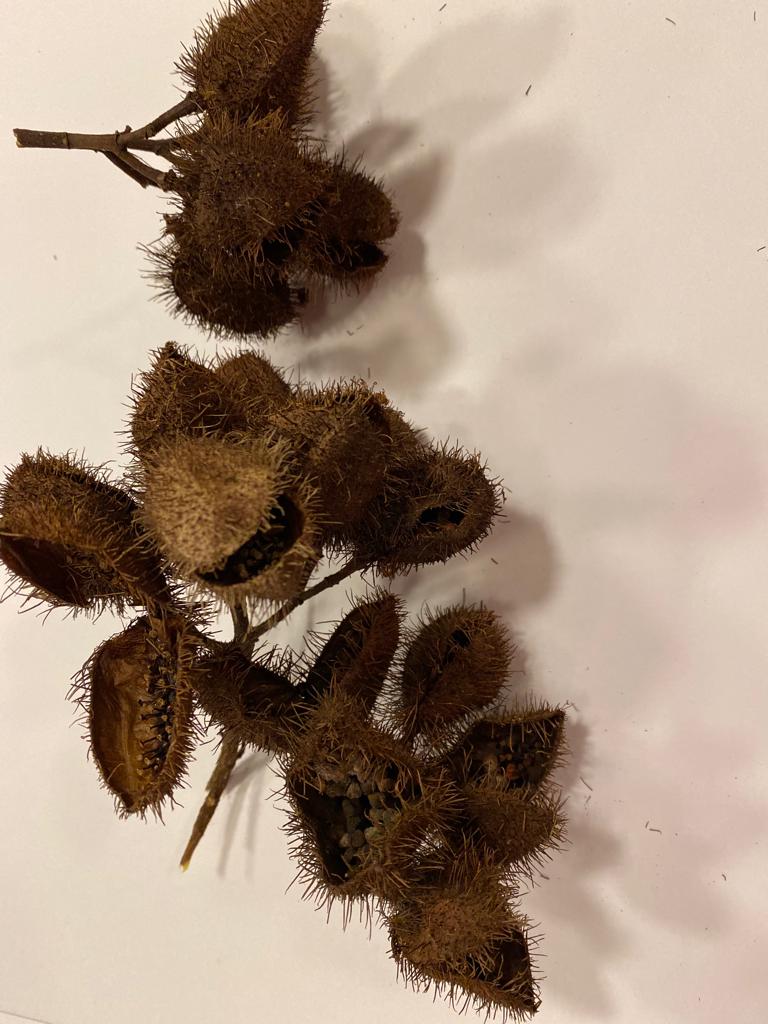
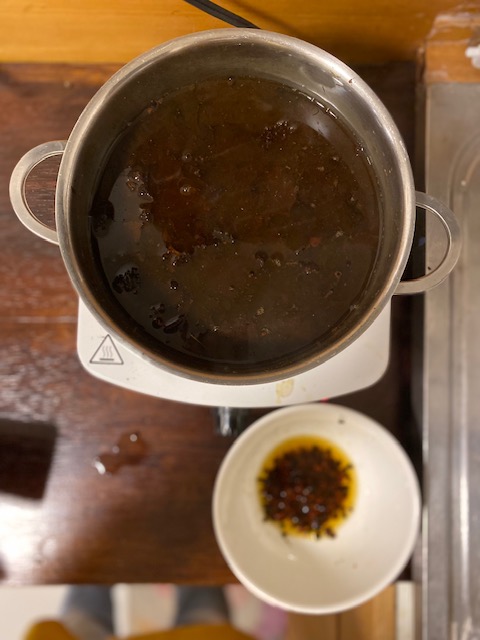
- Gado Libi leaf / Tradescantia pallida Purpurea /Purple heart dye

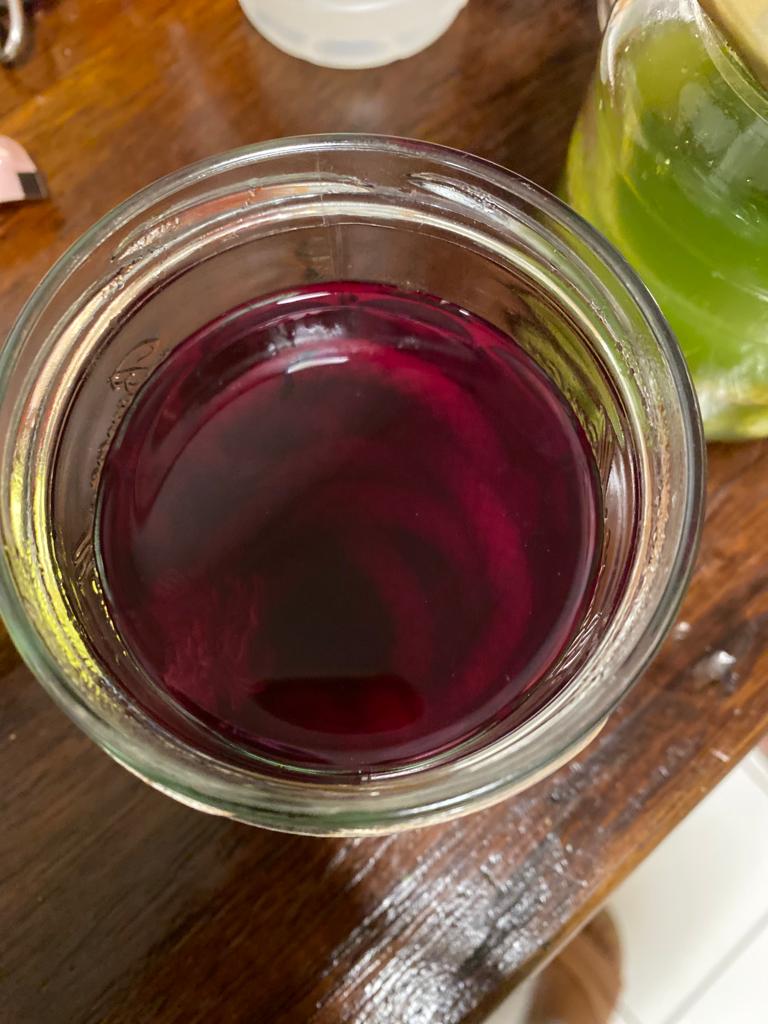
Later, while experimenting with Ph: Sour versus Alkaline this happened! Same plant!
The pink color is lime and the green color is Alum and Copper
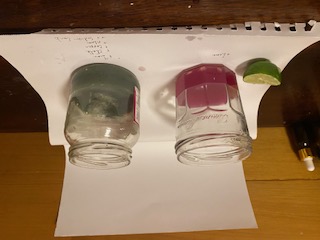
- Lantana Camara;Korsu wiri Korsu Wiri flower

- Astrocaryum aculeatum; Tucuma; Amana nut oil ( Credits to BDC Saamaka Gangasa who produced and bottled the orange palm oil)
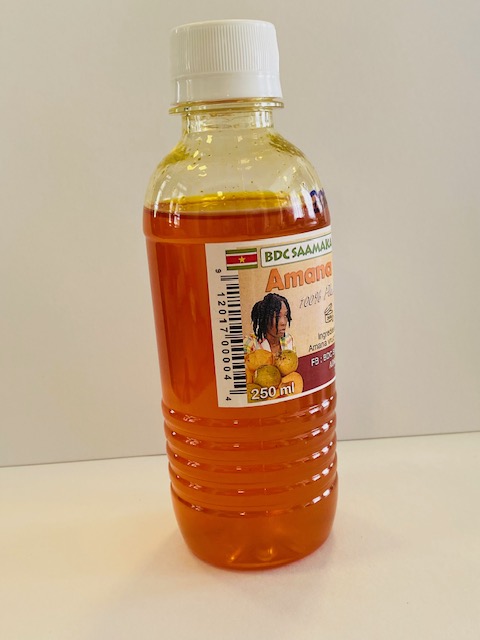
- Alternanthera dentata/ Brazilian Hot Red leaf
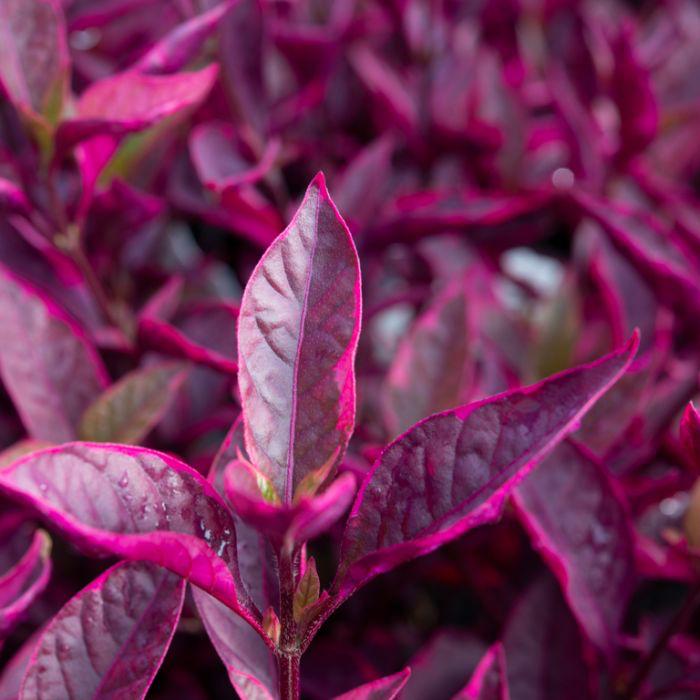
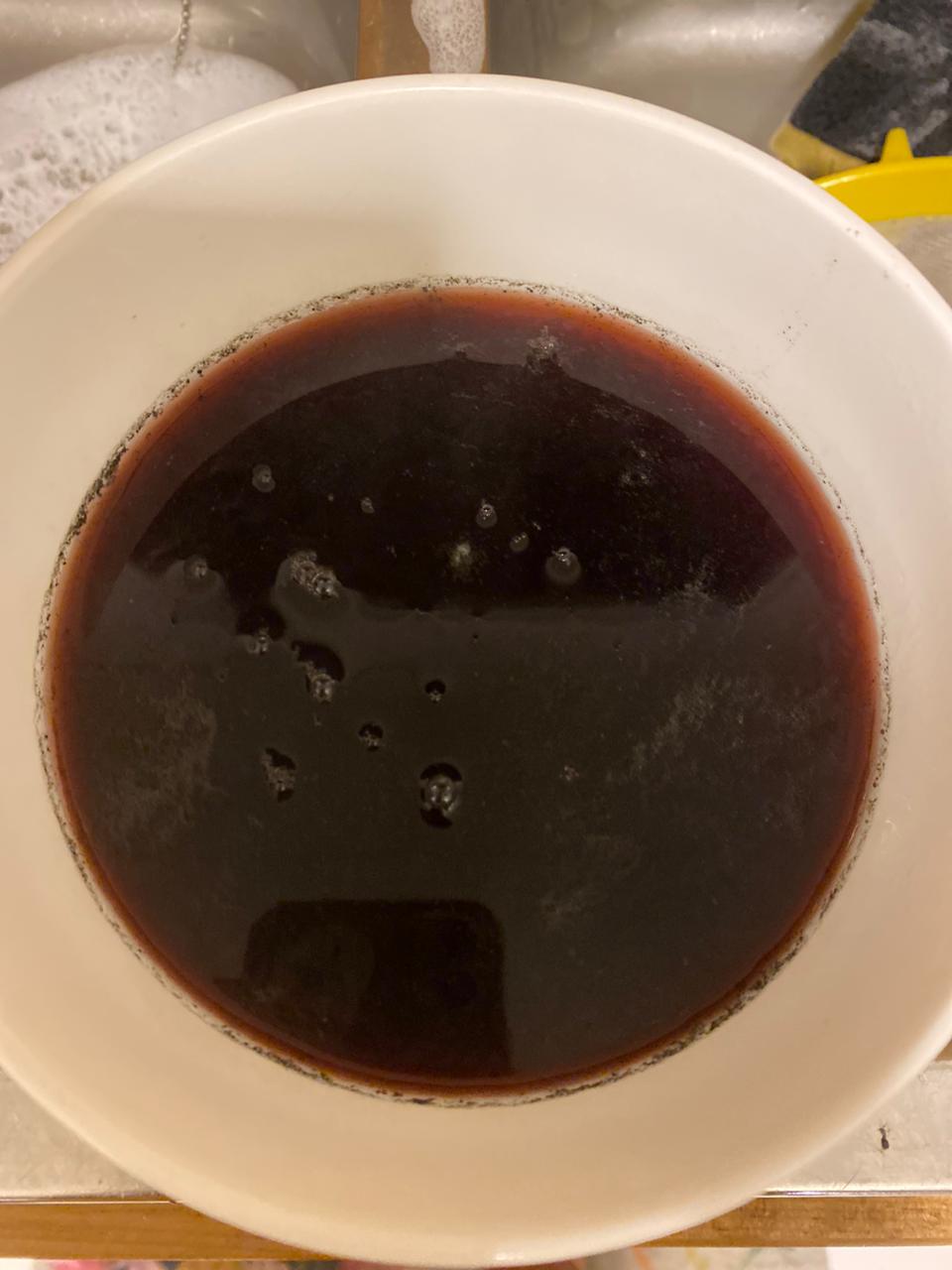
- Senna alata; Slabriki wiri Slabriki wiri flower Yellow
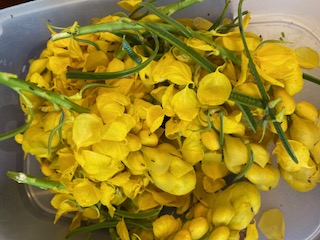


FINAL BIOCHROMES PROJECT¶
Here you can find pictures of my final project as well as a link to a video.
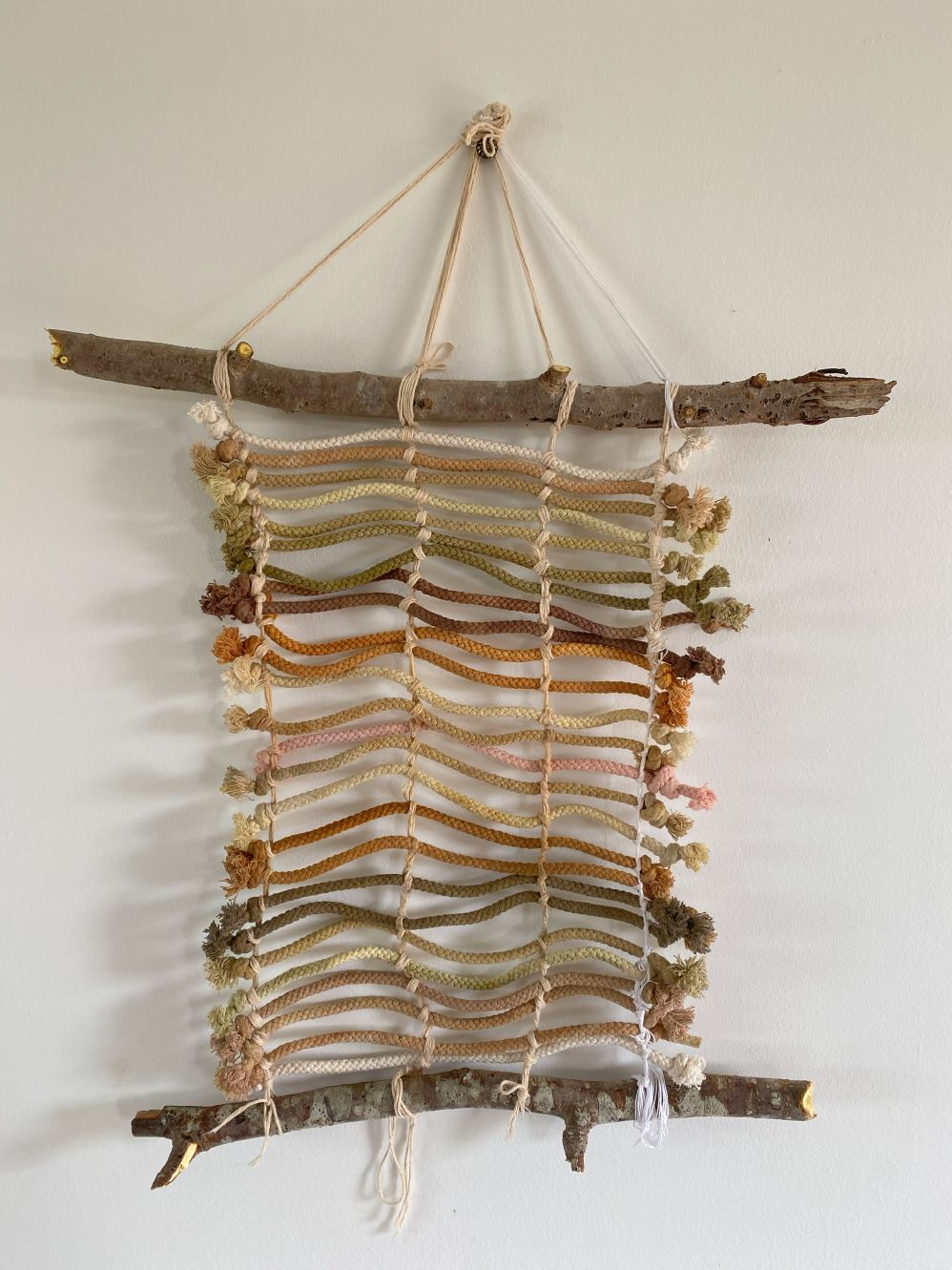

Tools¶
The tools used are mainly kitchen tools:
* Pots
* Food scale
* Sieve
* Funnel
* Wooden Spoons
* Lots of glass jars
Colorshot app¶
I decided to look for an app that does color analysis and I came across Colorshot, an app for people who are colorblind.
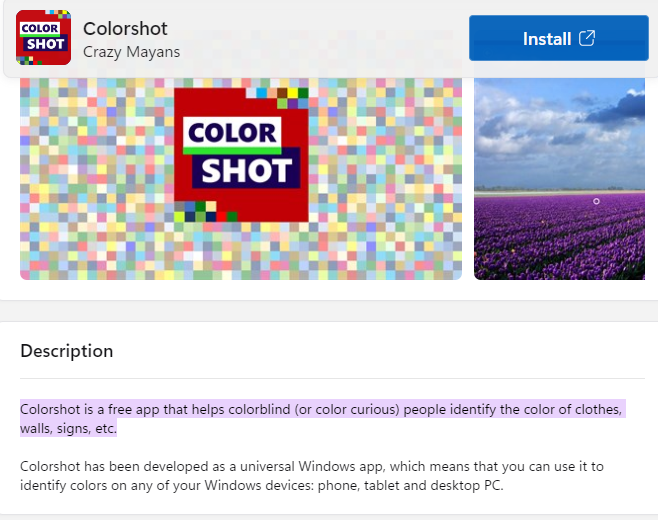
UPDATE ... Some thoughts about applying a color app like colorshot¶
I've seen that fresh biochromes are very bright but often not too stable, meaning they change once they dry in different stages. Also when the biochrome is mixed with mordants or is used in a biomaterial such as bioplastic, the color changes sometimes quite dramatically.
An app like colorshot could help to monitor the colorchanges by giving the color code in each stage of the process. This measn you can document the color codes and compare the change for example: Color code of a freshcut flower is... Color code of the fresh colorbath is .... Color code of dyed cotton - still wet is ... Color code of the dyed and dried cotton is ... Colorcode with mordant lime or vinegar is ...
Ingredients & Recipes¶
In each recipe I added 2 pieces of cotton rope: 1 with mangrove tannin and 1 with alum as a tannin.
Prepare this recipe [^1] by collecting the ingredients necessary, to be found in the list below:
| Plant name | Parts | Test# | Material (gr) | Water (ml) | Alum (gr) | Iron | Copper | Lime juice (ml) | Vinegar (ml) | Sodium Carbonate (gr) | Chalk (gr) | Other |
|---|---|---|---|---|---|---|---|---|---|---|---|---|
| Pandanus amaryllifolius; Pandan | leave | #1 | 53 gr | |||||||||
| Pandanus amaryllifolius; Pandan | leave | #2 | 53 gr | 8 gr | ||||||||
| Pandanus amaryllifolius; Pandan | leave | #3 | 53 gr | 8 gr | yes | |||||||
| Pandanus amaryllifolius; Pandan | leave | #4 | 53 gr | 1/2 lime | yes | Amana oil |
| Plant name | Parts | Test# | Material (gr) | Water (ml) | Alum (gr) | Iron | Copper | Lime juice (ml) | Vinegar (ml) | Sodium Carbonate (gr) | Chalk (gr) |
|---|---|---|---|---|---|---|---|---|---|---|---|
| Tradescantia pallida Purpurea; Gado Libi | leaves + stem | #1 | 132 gr | ||||||||
| Tradescantia pallida Purpurea; Gado Libi | leaves + stem | #2 | 132 gr | 23 gr | |||||||
| Tradescantia pallida Purpurea; Gado Libi | leaves + stem | #3 | 132 gr | yes | no | no | 1/2 a lime | no | no | no | |
| Tradescantia pallida Purpurea; Gado Libi | leaves + stem | #4 | 132 gr | yes | yes | yes | no | yes | yes |
| Plant name | Parts | Test# | Material (gr) | Water (ml) | Alum (gr) | Iron | Copper | Lime juice (ml) | Vinegar (ml) | Sodium Carbonate (gr) | Chalk (gr) |
|---|---|---|---|---|---|---|---|---|---|---|---|
| Bixa orellana;Annatto; Koeswe | seeds(dried) | #1 | |||||||||
| Bixa orellana;Annatto; Koeswe | seeds+seedpod (dried) | #2 | 74 gr | 11 gr | yes | yes | |||||
| Bixa orellana;Annatto; Koeswe | seeds+seedpod (dried) | #3 | 74 gr | yes | yes |
| Plant name | Parts | Test# | Material (gr) | Water (ml) | Alum (gr) | Iron | Copper | Lime juice (ml) | Vinegar (ml) | Sodium Carbonate (gr) | Chalk (gr) |
|---|---|---|---|---|---|---|---|---|---|---|---|
| Astrocaryum aculeatum; Tucuma; Amana | seed&fruit oil | #1 | 50ml |
| Plant name | Parts | Test# | Material (gr) | Water (ml) | Alum (gr) | Iron | Copper | Lime juice (ml) | Vinegar (ml) | Sodium Carbonate (gr) | Chalk (gr) |
|---|---|---|---|---|---|---|---|---|---|---|---|
| Lantana Camara;Korsu wiri | flower | #1 | 10 g |
| Plant name | Parts | Test# | Material (gr) | Water (ml) | Alum (gr) | Iron | Copper | Lime juice (ml) | Vinegar (ml) | Sodium Carbonate (gr) | Chalk (gr) | Other |
|---|---|---|---|---|---|---|---|---|---|---|---|---|
| Alternanthera dentata; Brazilian Red Hot | leaves + stem | #1 | 89 gr | |||||||||
| Alternanthera dentata; Brazilian Red Hot | leaves + stem | #2 | yes | yes | ||||||||
| Alternanthera dentata; Brazilian Red Hot | leaves + stem | #3 | yes | yes | yes | |||||||
| Alternanthera dentata; Brazilian Red Hot | leaves + stem | #4 | yes | yes |
| Plant name | Parts | Test# | Material (gr) | Water (ml) | Alum (gr) | Iron | Copper | Lime juice (ml) | Vinegar (ml) | Sodium Carbonate (gr) | Chalk (gr) |
|---|---|---|---|---|---|---|---|---|---|---|---|
| Senna alata; Slabriki wiri | flower | #1 | 131 gr | 600 ml |
Recycling the dye into pigments¶
Most of the color baths were used for the cotton ropes. To make pigment I made a second color bath from Gado Libi, Tradescantia pallida Purpurea (Purple heart).
Ingredients & Recipes¶
Prepare this recipe [^1] by collecting the ingredients necessary, to be found in the list below:
Info ingredients
* 600 ml color bath from Gado Libi, Tradescantia pallida Purpurea (Purple heart)
-
15 gr Alum
-
8 gr Sodium Carbonate (gr)
Producing the pigment¶
- Step 1: Make a color bath by cooking the biomaterial
- Step 2: Seperate the biomaterial from the color bath with a sieve and let it cool
- Step 3: Dissolve alum in hot water in a jar and in another jar separately dissolve Sodium Carbonate in hot water as well. Then pour them one by one in the color bath, soda first until you see a chemical reaction through color separation, precipitation, and the mix getting foamy on top. Make sure you have a jar with enough space.
Let it sit for a while so the color separates into two layers.
- Step 4: Pour out as much as possible from the clear layer into a second jar. Then filter the the muddy layer, by pouring it into a coffee filter and catching the rest of the color bath in another jar.
The substance in the filter is the pigment.

- Step 5: Place the filter in a cup and let the pigment dry. You can break it apart from the filter and pout the crumbs into a small glass jar.
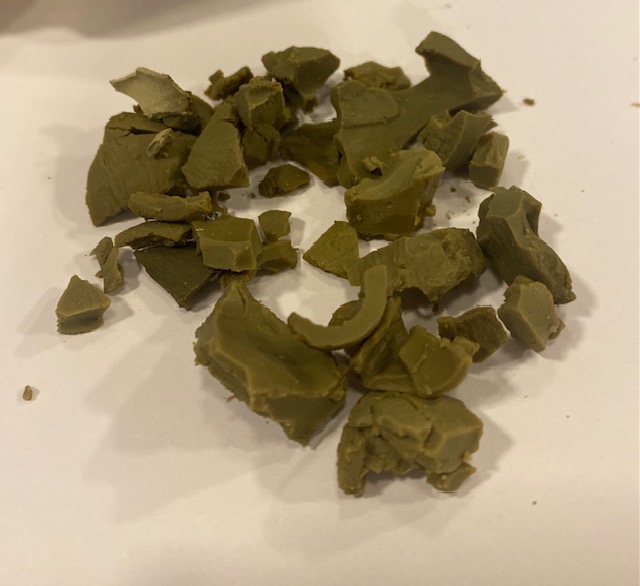
- Step 6: If there is still color in the left over bathwater, you can repeat the steps and try to get a second pigment. It will most probably be different from the first color pigment.
Result¶
I painted a dash of pigment on a white cotton fabric and here is the result:
Acording to the Colorshot app I made pistachio green and gold!!! (Big smile on my face :-D)
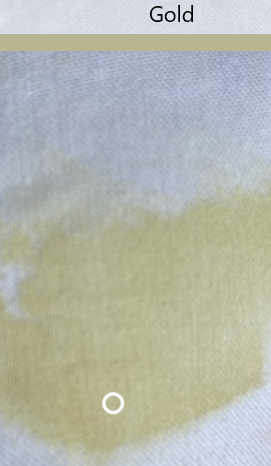
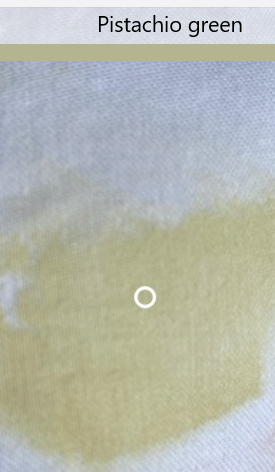
References:¶
Recipe Turning baking soda (Sodium Bi Carbonate) into Soda Ash (Sodium Corbonate) Making Sodium Corbonate
Using Mangrove as tannin Mangrove as tannin
Using Mangrove as tannin: Mangrove as tannin
